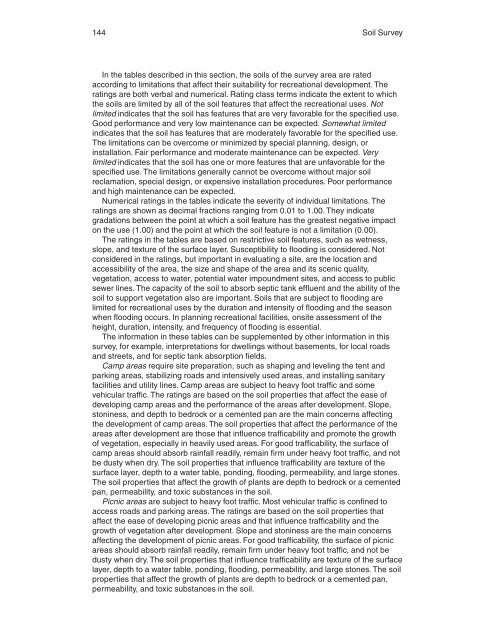Soil Survey of Murray and Whitfield Counties, Georgia
Soil Survey of Murray and Whitfield Counties, Georgia
Soil Survey of Murray and Whitfield Counties, Georgia
Create successful ePaper yourself
Turn your PDF publications into a flip-book with our unique Google optimized e-Paper software.
144 <strong>Soil</strong> <strong>Survey</strong><br />
In the tables described in this section, the soils <strong>of</strong> the survey area are rated<br />
according to limitations that affect their suitability for recreational development. The<br />
ratings are both verbal <strong>and</strong> numerical. Rating class terms indicate the extent to which<br />
the soils are limited by all <strong>of</strong> the soil features that affect the recreational uses. Not<br />
limited indicates that the soil has features that are very favorable for the specified use.<br />
Good performance <strong>and</strong> very low maintenance can be expected. Somewhat limited<br />
indicates that the soil has features that are moderately favorable for the specified use.<br />
The limitations can be overcome or minimized by special planning, design, or<br />
installation. Fair performance <strong>and</strong> moderate maintenance can be expected. Very<br />
limited indicates that the soil has one or more features that are unfavorable for the<br />
specified use. The limitations generally cannot be overcome without major soil<br />
reclamation, special design, or expensive installation procedures. Poor performance<br />
<strong>and</strong> high maintenance can be expected.<br />
Numerical ratings in the tables indicate the severity <strong>of</strong> individual limitations. The<br />
ratings are shown as decimal fractions ranging from 0.01 to 1.00. They indicate<br />
gradations between the point at which a soil feature has the greatest negative impact<br />
on the use (1.00) <strong>and</strong> the point at which the soil feature is not a limitation (0.00).<br />
The ratings in the tables are based on restrictive soil features, such as wetness,<br />
slope, <strong>and</strong> texture <strong>of</strong> the surface layer. Susceptibility to flooding is considered. Not<br />
considered in the ratings, but important in evaluating a site, are the location <strong>and</strong><br />
accessibility <strong>of</strong> the area, the size <strong>and</strong> shape <strong>of</strong> the area <strong>and</strong> its scenic quality,<br />
vegetation, access to water, potential water impoundment sites, <strong>and</strong> access to public<br />
sewer lines. The capacity <strong>of</strong> the soil to absorb septic tank effluent <strong>and</strong> the ability <strong>of</strong> the<br />
soil to support vegetation also are important. <strong>Soil</strong>s that are subject to flooding are<br />
limited for recreational uses by the duration <strong>and</strong> intensity <strong>of</strong> flooding <strong>and</strong> the season<br />
when flooding occurs. In planning recreational facilities, onsite assessment <strong>of</strong> the<br />
height, duration, intensity, <strong>and</strong> frequency <strong>of</strong> flooding is essential.<br />
The information in these tables can be supplemented by other information in this<br />
survey, for example, interpretations for dwellings without basements, for local roads<br />
<strong>and</strong> streets, <strong>and</strong> for septic tank absorption fields.<br />
Camp areas require site preparation, such as shaping <strong>and</strong> leveling the tent <strong>and</strong><br />
parking areas, stabilizing roads <strong>and</strong> intensively used areas, <strong>and</strong> installing sanitary<br />
facilities <strong>and</strong> utility lines. Camp areas are subject to heavy foot traffic <strong>and</strong> some<br />
vehicular traffic. The ratings are based on the soil properties that affect the ease <strong>of</strong><br />
developing camp areas <strong>and</strong> the performance <strong>of</strong> the areas after development. Slope,<br />
stoniness, <strong>and</strong> depth to bedrock or a cemented pan are the main concerns affecting<br />
the development <strong>of</strong> camp areas. The soil properties that affect the performance <strong>of</strong> the<br />
areas after development are those that influence trafficability <strong>and</strong> promote the growth<br />
<strong>of</strong> vegetation, especially in heavily used areas. For good trafficability, the surface <strong>of</strong><br />
camp areas should absorb rainfall readily, remain firm under heavy foot traffic, <strong>and</strong> not<br />
be dusty when dry. The soil properties that influence trafficability are texture <strong>of</strong> the<br />
surface layer, depth to a water table, ponding, flooding, permeability, <strong>and</strong> large stones.<br />
The soil properties that affect the growth <strong>of</strong> plants are depth to bedrock or a cemented<br />
pan, permeability, <strong>and</strong> toxic substances in the soil.<br />
Picnic areas are subject to heavy foot traffic. Most vehicular traffic is confined to<br />
access roads <strong>and</strong> parking areas. The ratings are based on the soil properties that<br />
affect the ease <strong>of</strong> developing picnic areas <strong>and</strong> that influence trafficability <strong>and</strong> the<br />
growth <strong>of</strong> vegetation after development. Slope <strong>and</strong> stoniness are the main concerns<br />
affecting the development <strong>of</strong> picnic areas. For good trafficability, the surface <strong>of</strong> picnic<br />
areas should absorb rainfall readily, remain firm under heavy foot traffic, <strong>and</strong> not be<br />
dusty when dry. The soil properties that influence trafficability are texture <strong>of</strong> the surface<br />
layer, depth to a water table, ponding, flooding, permeability, <strong>and</strong> large stones. The soil<br />
properties that affect the growth <strong>of</strong> plants are depth to bedrock or a cemented pan,<br />
permeability, <strong>and</strong> toxic substances in the soil.
















